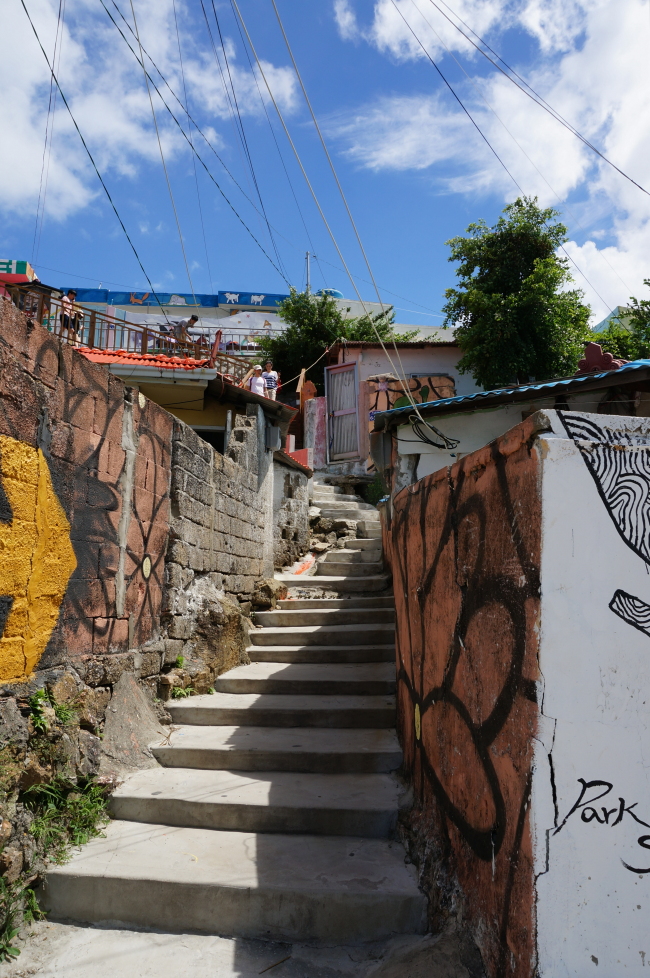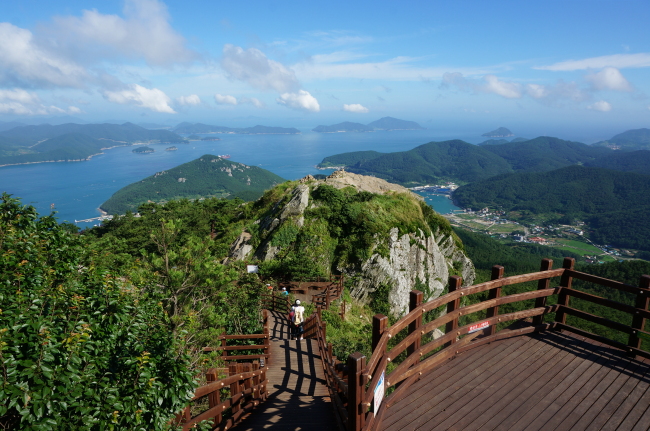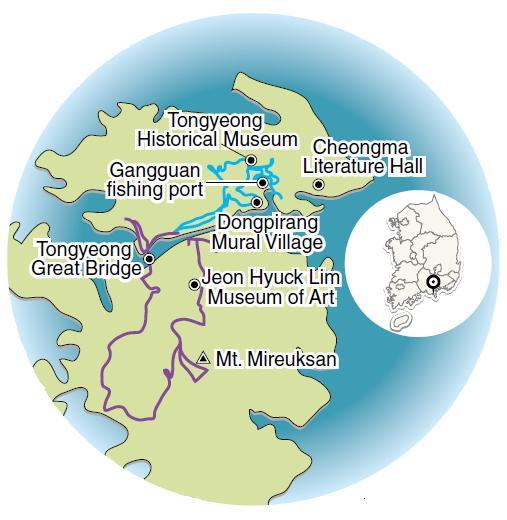This is the sixth installment in an 11-part series that introduces some of the best walking trails in Korea. Based on each trail’s popularity and the recommendations of travel experts and the Culture Ministry, The Korea Herald has selected the 10 best places for walking and hiking. The series received funding from the Korea Press Foundation. ― Ed.
Tongyeong is a small fishing port city famous for fresh seafood. The small city attracts thousands of tourists throughout the year just to taste the country’s best seafood. On top of being one of Korea’s best culinary destinations, the city is also the birthplace of many of the country’s great novelists, poets and artists: Novelist Park Kyung-ni, poet Ryu Chi-hwan, painter Jeon Hyuck-lim and composer Yun Isang all hail from Tongyeong.
The celebrated cultural figures’ birthplaces, memorial halls and museums are scattered throughout the city and in 2011, the Tongyeong Cultural Foundation created a cultural trail that connects the spots.
The cultural trail is the first walking trail of Tongyeong’s “Iyagil.” Derived from the regional dialect ― “Iya” means sister ― the 9.4-kilometer trail invites tourists to a visitor-friendly walking experience akin to walking with their brothers or sisters.
“The cultural trail follows the traces of Tongyeong’s cultural figures. It goes to birthplaces, memorial halls and museums,” said Lee Mi-hee of Tongyeong city’s tourism department.
The city also created a second trail named Mireukdogil that goes around Mireukdo Island, which is connected to the main city by bridge. From the island’s highest mountain, one can take in the breathtaking landscape of the peninsula’s south coast dotted with hundreds of small islands.
The scarcity of signs along the trails and lack of maps offering information on the walking trails make it difficult to follow the paths without getting lost. A somewhat useful guide is a walking tour mobile app created by the Culture Ministry which pinpoints each destination on a Naver mobile map and suggests a path to follow.
Not many people were seen walking along the Iyagil, though more people loitered at each destination. The trail is still not well known and more work needs to be done to promote it.
Trail No. 1: Rich, vibrant cultural scene
The first trail starts at the Culture Plaza in the small port of Gangguan, where the Tongyeong Theater Art Festival was held from July 12 to July 20 featuring plays and musical performances by young theater groups and college students on the small stages at the plaza.
However, visitors may find the lively port scene of Gangguan more interesting. Rows of seafood restaurants, local eateries and the traditional Jungang Fish Market draw tourists to the dynamic port. Most of the major cultural landmarks are within walking distance from Gangguan.
The Dongpirang mural village is a two-minute walk from the port. To the left, one can reach the outdoor sculpture park on Nammangsan Mountain and the Cheongma Literature Hall where poet Ryu Chi-hwan once lived and wrote some of the greatest works of poetry in the Korean language. To the right, the seaside road leads to the southern part of the city, Mireukdo Island, through an underwater tunnel.
 |
A narrow alley in Dongpirang mural village in Tongyeong, South Gyeongsang Province (Lee Woo-young/The Korea Herald) |
Once the poorest neighborhood of Tongyeong, Dongpirang is now the artistic center of the city, boasting colorful murals that attract visitors and artists throughout the year.
The village is a museum of street paintings; they decorate its stairway, winding walls, a dead-end alley and roofs of cramped houses.
“It is a beautiful and warm place. One can find solace here,” said Kim Jae-sin, an artist who has been painting the village for four years.
Trail No. 2: Breathtaking view of island-dotted coast
At the end of the seaside road along the first trail is the underwater tunnel that connects the mainland and Mireukdo Island. Built in 1932 during the Japanese colonial rule, the pedestrian tunnel is now registered as an item of Modern Cultural Heritage. The less-than-500-meter-long tunnel has pictures on the wall showing the construction process and travel information on Tongyeong.
Just outside the tunnel and near the port stands a hall dedicated to poet Kim Chun-su, who is famous for the poem “Flower.” The hall displays original manuscripts and the books, clothes and furniture he used in his lifetime.
One should not forget to stop by the Omisa honey bread shop in front of Tongyeong Middle and High School.
 |
The view of the south coast dotted with small islands seen from Mireuksan Mountain in Tongyeong, South Gyeongsang Province (Lee Woo-young/The Korea Herald) |

Stuffed with red beans, the fried bread ball glossed with syrup is a famous local delicacy.
“It’s the bread that recalls old memories. In the old days, there were no bakeries in Tongyeong. The only shop that sold bread was the Omisa honey bread shop. People still talk about the bread they used to enjoy after school,” said Kim Bok-ju of the city’s Tourism Information Center.
The name Omisa derives from the name of a dry cleaner’s which stood next to the honey bread shop.
“The dry cleaner’s was also a famous place, but then it closed for some reason. And the bread store took their name and got more famous,” Kim added.
The Museum of Jeong Hyuck Lim is located along the uphill road to Mireuksan Mountain. Hailed as one of the greatest artists from Tongyeong, Jeon is famous for abstract paintings featuring vibrant colors that portray his hometown. The artist’s distinctive style won him such titles as “Asia’s Matisse” and “Picasso of Tongyeong.”
With lush green trees as a background, the museum, opened in 2003, is Jeon’s home renovated to house his paintings and historical documents related to the artist’s life. The museum is closed on Monday and Tuesday.
Walking further up leads to the entrance of Mireuksan Mountain. There are a couple of small Buddhist temples where one can rest while hiking up the 461-meter mountain. Gwangeum Temple and Dosol Temple are the perfect places to stop and take the time to enjoy the beautiful coastline view surrounded by a quiet and serene setting of the temple.
As one nears the top of the mountain, a breathtaking view of Hallyeosudo and the port city of Tongyeong unfolds. Dotted with hundreds of islands, the coastline is indeed picture-perfect.
By Lee Woo-young (
wylee@heraldcorp.com)






![[Herald Interview] 'Trump will use tariffs as first line of defense for American manufacturing'](http://res.heraldm.com/phpwas/restmb_idxmake.php?idx=644&simg=/content/image/2024/11/26/20241126050017_0.jpg)

![[Health and care] Getting cancer young: Why cancer isn’t just an older person’s battle](http://res.heraldm.com/phpwas/restmb_idxmake.php?idx=644&simg=/content/image/2024/11/26/20241126050043_0.jpg)

